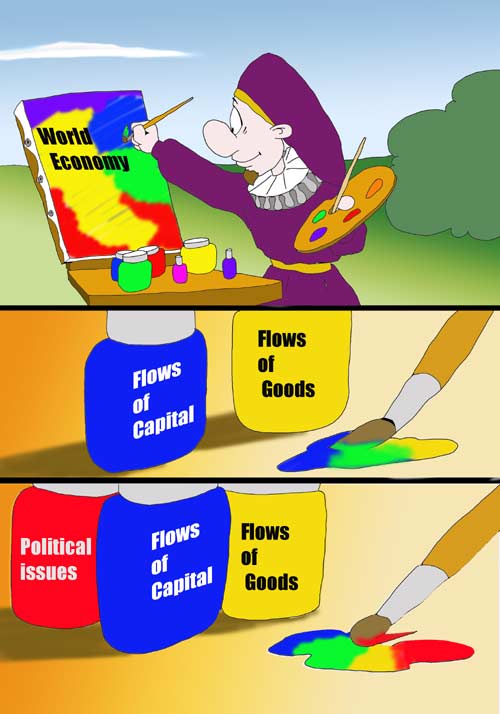Part V. What Could Shape the Market?


Business sentiment and economy perspective
Big attention is attracted by this data. Depending on what sentiment has consumers and companies – they act differently. If the economic outlook is positive and the economy shows stable solid growth (for mature economies – 3-5% per year), then consumers feel confident and safe with their future and spend more money. Companies receive stronger growth in revenues and make more money, since they can invest more in growth of their business and, as a result, also spend more money. When everybody spends money it makes a positive impact on the economy.
When perspectives for the economy become weaker, or when it already has fallen into contraction, then consumers do not spend and save more. Companies earn less and do not increase production, since consumers do not buy more. This means that overall spending declines.
That’s why it is important to catch news and opinions from well-known analysts and financial authorities (the most important of them is the Central Bank) about economic outlook.
Flows of Capital
With the fast development of technologies, internet and globalization currently almost any person could move money anywhere as fast as blink of an eye. Double click and you may buy futures on the Nikkei, sell bonds and speculate on exotic currencies or options simultaneously. Another click and you may withdraw your money that you’ve earned today on Japan stocks just 2 hours later. Since currently it’s very simple and fast to move capital to any location all over the globe, we have to keep an eye on where the “Big Whales” move their money.
In fact, capital flow is the amount of money that is transferred in or out of some particular country because of investors are buying or selling something. As a result, traders watch over an indicator that is called “Capital flow balance” that could be positive or negative. A particular country will have a positive cash flow balance, if investments coming into the country are greater than outflow from the country. In general this means that investors find it attractive to put their money in some assets of that country, including the currency of that country. Otherwise is true also – when outflow exceeds inflow and the balance turns negative, it means that investors close their positions and leave this country to search for something more attractive.
So as we’ve said before, to invest in domestic assets, investors need domestic money first. Hence, as they’ve decided to come in and invest in that country, they need to purchase (or borrow) domestic currency first. When more investors are stepping in, the demand for domestic currency significantly increases and its rate starts to grow. And vice versa – when investors start to abandon this country, they start to slough domestic currency, supply increases and it start to fall compared to other currencies.
What kind of economy do most investor like? - Those that give a high interest rate on their investment and stability. So, if economy shows solid growth, high interest rates and safety (mature economy), this country usually has solid positive capital flows balance. This is a typical situation for US in period of high interest rates and solid growth pace of the economy.
Flows of Goods
Another kind of flows depends not on investors but on countries themselves. This is goods flows or trading. International commerce now is a very developed part of the overall global financial environment. All countries trade with each other – selling their own produced goods (export) and buying goods of other countries (import). If you check where different goods were made, you’ll find out that many of them were made in another country. All merchandise trading around the globe is accompanied by money exchange, and, as a result, money flow into and out of some country.
So the difference in the value of imported goods and exported goods is named the “Trade Balance”. If country sells more goods (export) than it buys (import) then it has positive Trading Balance and vice versa:
Positive Trade Balance = Export > Import
Negative Trade Balance = Import > Export
Pipruit: So, and what impact of trade balance on currency?
Commander in Pips: Very simple. To buy something from another country, you need to purchase its own currency first. Second, if you buy more than sell, that currency will be in advance, since you need to buy more foreign currency to purchase all that you need. Hence foreign currency will increase in value, since demand for it is growing. If you will buy it for your domestic currency, then your currency will depreciate, since you will have to sell it. The most positive trade balance economies are China and Japan.
Pipruit: And how does the US Dollar holds well in that case?
Commander in Pips: That’s because China and Japan sell their goods for US Dollars, but they do not convert them in CNY and JPY but invest them in US Bonds. Their holdings in US Bonds have reached an outstanding value around $1.5 Trillion – that is a hidden trading deficit of US. If they will quickly sell them and invest those dollars in own currencies – then the US dollar will fall miserably.
Political issues are not separate from economy
Sometimes it happens when some country could not exit from some problems just by economic methods. They need political intervention. This is even more so in periods of great depressions and recessions, when the economy demands some extraordinary methods, financial resources and even law changes. For example, as with the Marshall plan after WW II. But nowadays we see that the economy has really big problems to recover, we already see political crisis when Republicans were not able to agree with Democrats on the US debt ceiling. So real changes in law, instability or separation inside the government, orunexpected changes in the ruling administration could have strong influence on overall markets, including domestic currency value.
Comments
O
One-fm
5 years ago,
Registered user
Good work.
Table of Contents
- Introduction
- FOREX - What is it ?
- Why FOREX?
- The structure of the FOREX market
- Trading sessions
- Where does the money come from in FOREX?
- Different types of market analysis
- Chart types
- Support and Resistance
-
Candlesticks – what are they?
- Part I. Candlesticks – what are they?
- Part II. How to interpret different candlesticks?
- Part III. Simple but fundamental and important patterns
- Part IV. Single Candlestick Patterns
- Part V. Double Deuce – dual candlestick patterns
- Part VI. Triple candlestick patterns
- Part VII - Summary: Japanese Candlesticks and Patterns Sheet
-
Mysterious Fibonacci
- Part I. Mysterious Fibonacci
- Part II. Fibonacci Retracement
- Part III. Advanced talks on Fibonacci Retracement
- Part IV. Sometimes Mr. Fibonacci could fail...really
- Part V. Combination of Fibonacci levels with other lines
- Part VI. Combination of Fibonacci levels with candle patterns
- Part VII. Fibonacci Extensions
- Part VIII. Advanced view on Fibonacci Extensions
- Part IX. Using Fibonacci for placing orders
- Part X. Fibonacci Summary
-
Introduction to Moving Averages
- Part I. Introduction to Moving Averages
- Part II. Simple Moving Average
- Part III. Exponential Moving Average
- Part IV. Which one is better – EMA or SMA?
- Part V. Using Moving Averages. Displaced MA
- Part VI. Trading moving averages crossover
- Part VII. Dynamic support and resistance
- Part VIII. Summary of Moving Averages
-
Bollinger Bands
- Part I. Bollinger Bands
- Part II. Moving Average Convergence Divergence - MACD
- Part III. Parabolic SAR - Stop And Reversal
- Part IV. Stochastic
- Part V. Relative Strength Index
- Part VI. Detrended Oscillator and Momentum Indicator
- Part VII. Average Directional Move Index – ADX
- Part VIII. Indicators: Tightening All Together
- Leading and Lagging Indicators
- Basic chart patterns
- Pivot points – description and calculation
- Elliot Wave Theory
- Intro to Harmonic Patterns
- Divergence Intro
- Harmonic Approach to Recognizing a Trend Day
- Intro to Breakouts and Fakeouts
- Again about Fundamental Analysis
- Cross Pair – What the Beast is That?
- Multiple Time Frame Intro
- Market Sentiment and COT report
- Dealing with the News
- Let's Start with Carry
- Let’s Meet with Dollar Index
- Intermarket Analysis - Commodities
- Trading Plan Framework – Common Thoughts
- A Bit More About Personality
- Mechanical Trading System Intro
- Tracking Your Performance
- Risk Management Framework
- A Bit More About Leverage
- Why Do We Need Stop-Loss Orders?
- Scaling of Position
- Intramarket Correlations
- Some Talk About Brokers
- Forex Scam - Money Managers
- Graduation!